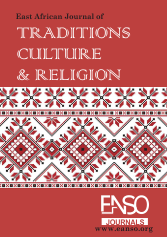Culinary Globalisation: The Global Spread of Recipes through Instagram and the Impact on Traditional Kenyan Foods
Abstract
The importance of authentic traditional cuisines goes beyond nutritional benefits and sustenance. They represent cultural heritage and demand to be preserved. In an age where social media platforms inform and have the power to influence consumption choices, Kenyan traditional cuisine faces threats of abandonment for more “insta-worthy” dishes. This study examines the impact of Instagram on the globalisation of food culture and its implications on traditional Kenyan cuisines. Rooted in homogenization theory, the research explores whether Instagram promotes the erosion of local culinary practices by promoting other globally recognisable cuisines. A qualitative approach was applied, combining content analysis of 28 food bloggers’ Instagram accounts with semi-structured interviews involving chefs, bloggers, and Instagram users. Findings reveal that globally popular foods- particularly fast foods such as chicken wings- dominate in visibility, while Kenyan local dishes are underrepresented, to the extent of being described as “boring”. Kenyan food bloggers often fuse traditional foods with global elements to enhance engagement, but risk diluting the authenticity of the dishes. In a rather unexpected turn, the study also highlights some creators who have embraced traditional foods and cooking methods as their niche, attracting significantly higher engagement metrics compared to the modern creators. Several participants also expressed renewed interest in traditional foods for health reasons. The findings reflect a duality in Instagram's role, complicating the total homogenization assumption aided by digital spaces. The paper concludes by recommending stronger heritage preservation strategies, including UNESCO’s food heritage initiative, national cultural festivals, and leveraging social media to persuade younger generations to promote traditional culinary practices.
Downloads
References
Balogun, S. & Aruoture, E. (2024). Cultural Homogenization vs. Cultural Diversity: Social media’s double-edged sword in the age of globalization. Research Gate. 14. 1491-1512. https://www.researchgate.net/publication/382994264_Cultural_Homogenization_Vs_Cultural_Diversity_Social_Media's_Double-EDGED_SWORD_IN_THE_AGE_OF_GLOBALIZATION
Bragg. M, Lutfeali. S., Greene. T., Osterman, J. and Dalton, M. (2021). How food marketing on Instagram shapes adolescents’ food references: Online randomized trial. J Med Internet Res. URL: https://www.jmir.org/2021/10/e28689
Creswell, J. W., & Creswell, J. D. (2018). Research design: Qualitative, quantitative, and mixed methods approaches.
Feldman, Z. (2021). ‘Good food’ in an Instagram age: Rethinking hierarchies of culture, criticism and taste. European Journal of Cultural Studies, 24(6), 1340- 1359. https://doi.org/10.1177/13675494211055733(Original work published 2021).
Herman, J. L. (2017). #EatingfortheInsta: A Semiotic Analysis of Digital Representations of Food on Instagram. Graduate Journal of Food Studies, 04(02). https://doi.org/10.21428/92775833.6889719f
Khan, M. (2024). Nutrigenomics: How your genes influence your nutritional needs and health. Science Direct. https://doi.org/10.1093/ajcn/83.2.436S
Lee, S. (2025). Cultural homogenization in food: Understanding the impact on global cuisine and nutrition. Number Analytics. https://www.numberanalytics.com/blog/cultural-homogenization-food-nutrition-guide
Lee, S. (2025, June 17). The cultural homogenization paradox: Navigating the tensions between cultural exchange and cultural erasure. Number Analytics. https://www.numberanalytics.com/blog/cultural-homogenization-paradox#:~:text=Cultural%20Resistance:%20This%20perspective%20emphasizes%20the%20agency,of%20globalization%20and%20maintaining%20their%20unique%20identities.
Mendelson Forman, J. (2024, July 17). Gastrodiplomacy. Oxford Research Encyclopedia of Food Studies. Retrieved 26 Jun. 2025, from https://oxfordre.com/foodstudies/view/10.1093/acrefore/9780197762530.001.0001/acrefore-9780197762530-e-18.
Ogar, J. N., Nwoye, L., & Bassey, S. A. (2019). Archetype of globalization: Illusory comfort of neo-colonialism in Africa. International Journal of Humanities and Innovation (IJHI), 2(3), 90– 95. https://doi.org/10.33750/ijhi.v2i3.46
Okech, R. and Timothy, D. (2023). Culinary Traditions and Heritage Foods in Africa.
Osorio, S., Frew, E., Lade, C., & Williams, K. (2022). Blending tradition and modernity: Gastronomic experiences in High Peruvian cuisine. Imprint Routledge. https://doi.org/10.4324/9781003357322-8
Palmer, T. (2004). Globalization and culture: Homogeneity, diversity, identity, liberty.
Strugar, T. (2025). Soft Power with Flavour. Conflux Centre. https://www.confluxcenter.org/soft-power-with-flavour/
Trisutaguna, I. N., Abdelrahman, L., & Ramli, R. (2025). Food and Culture: An Anthropological Study of Culinary Traditions. Journal of Humanities Research Sustainability, 2(2), 56–66. https://doi.org/10.70177/jhrs.v2i2.1940
United Nations Educational, Scientific and Cultural Organization (UNESCO). (2025, April 8). Food and intangible heritage, a flavourful relationship. https://courier.unesco.org/en/articles/food-and-intangible-heritage-flavourful-relationship
Walsh, B. (2014, March 4). Our global diet is becoming increasingly homogenized—and that’s risky. Time. https://time.com/12366/global-diet-becomes-homogenized/
Young, L. (2023, August 1). Your genes may influence what you like to eat. Scientific American.
Copyright (c) 2025 Nkatha Wainaina

This work is licensed under a Creative Commons Attribution 4.0 International License.




























